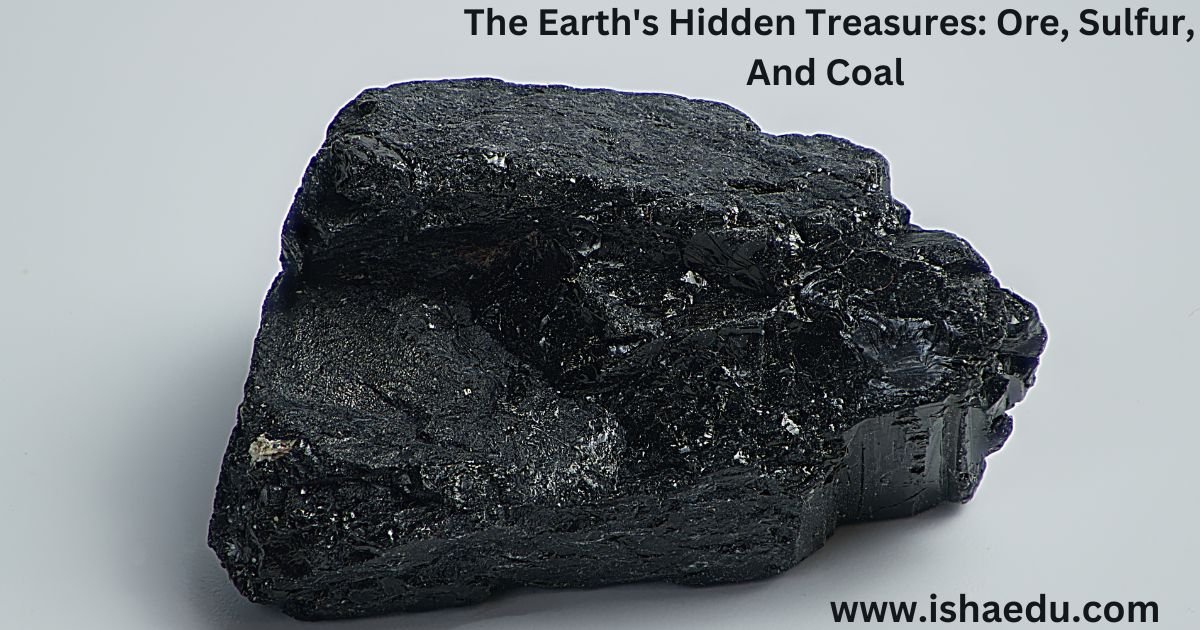The Earth’s Hidden Treasures: Ore, Sulfur, And Coal

The Earth’s Hidden Treasures: Ore, Sulfur, And Coal
Beneath the Earth’s facade lies a diverse array of invaluable assets awaiting exploration. These riches, crafted through eons of geological processes, serve as indispensable elements for a myriad of industries and technological advancements. Today, we embark on an exploration of the captivating realm of ore, sulfur, and coal, delving into their origins, characteristics, and applications.

Ore: The Foundations of Human Progress
Ore represents a naturally occurring amalgamation of minerals or metals. From the lustrous gold adorning jewelry to the robust steel constituting the infrastructure’s backbone, ores stand as the elemental building blocks propelling human advancement. The extraction and refinement of metals from ores, known as metallurgy, trace its roots back to ancient civilizations.
Sulfur: Nature’s Adaptable Alchemy
Sulfur, a non-metallic element, manifests in diverse forms, from vivid yellow crystals to emanations from volcanic vents. This versatile element assumes a pivotal role across various industries, contributing to fertilizers and insecticides in agriculture, as well as rubber vulcanization in tire manufacturing. Its unique properties extend its utility to batteries, detergents, and pharmaceuticals.
Coal: Catalyst of the Industrial Epoch
Coal, a sedimentary rock formed from fossilized plant matter, has long been the primary energy source for electricity generation, machinery propulsion, and residential heating. While environmental concerns are leading to a gradual decline in coal’s role in energy production, it remains a vital resource in certain sectors, particularly steel production.
Urgency of Prudent Resource Management
The extraction and utilization of these resources pose inherent environmental and social challenges. Mining activities can alter landscapes, contaminate water sources, and jeopardize ecosystems. Additionally, the combustion of fossil fuels like coal contributes to greenhouse gas emissions and climate change.
Hence, practicing responsible resource management is imperative. This involves minimizing environmental impact through sustainable mining practices, embracing cleaner technologies, and exploring alternative energy sources. Through the adoption of responsible practices, we can preserve the enduring benefits of these invaluable resources while safeguarding the planet for generations to come.
Conclusion
Ore, sulfur, and coal represent merely a glimpse into the Earth’s concealed treasures. Understanding their origins, characteristics, and applications enables us to grasp their significance in our lives. Simultaneously, acknowledging the challenges tied to their extraction and usage emphasizes the importance of advocating for responsible resource management. By championing these practices, we unlock the potential of these natural resources for humanity’s advancement while ensuring the well-being of our planet.

FAQs
What is an earth ore?
An earth ore is like a treasure trove concealed in the rocks! It is a natural deposit that contains precious materials, such as metals or jewels, in concentrations large enough to extract and utilize. These minerals power a variety of devices, including buildings and phones, but mining them influences the environment, so we must proceed with caution.
What are the 4 types of mining?
There are four major forms of mining:
- Surface: Similar to peeling back an onion, this eliminates layers to access resources near the surface.
- Underground: Imagine excavating tunnels like a mole to reach deeper resources.
- Placer: This is the process of sifting through water-worn materials to locate precious minerals, similar to panning for gold.
- In-situ: This method dissolves precious minerals underground without digging them up.
What is the concept of ore and ore deposits?
Ore is a naturally occurring concentration of precious materials, such as metals or jewels, that are worth digging up. These mineral pockets, known as ore deposits, developed over millions of years and are concealed under rocks. We remove the good stuff (ore minerals) while leaving the remainder (gangue) behind. Understanding mineral deposits allows us to discover and utilize these resources properly.
Is coal an ore?
Coal isn’t strictly an ore. Ores are often mineral deposits rich in metals or precious minerals that can be mined and purified. Coal, on the other hand, is a sedimentary rock created by the fossilized remnants of plants over millions of years. While it is an important resource for fuel and other reasons, it is not refined in the same way that ores are.
So, although both ores and coal are significant commodities found on Earth, they originate from different sources and have distinct qualities.
Where is coal ore?
Coal is a rock created by millions of years of plant growth, not an ore. Deposits may be found on every continent, with the majority concentrated in the United States, Europe, Asia, and Australia. Remember, coal production has environmental consequences, therefore we must utilize it properly.
What is the best ore of coal?
There is no one “best” coal kind since each has benefits and drawbacks for diverse applications. Which kind is most appropriate depends on factors such as required heat, abundance, and environmental effects. However, it is crucial to realize that all coal consumption has drawbacks, and cleaner energy alternatives are often preferred.
How coal is made?
Coal does not develop in the same way that items do; it takes millions of years. Plants in marshy environments become buried behind layers of rock, where extreme heat and pressure roast them over time, transforming them into the coal we know today. The longer they’re “cooked,” the tougher and denser they become.
What is coal ore used for?
Coal is not strictly an ore, but rather a rock produced by ancient plants. Historically, it was used for:
- Electricity: Coal used to be the primary fuel for power plants.
- Heating: Coal was used to keep homes and buildings warm.
- Steel: Coke obtained from coal contributed to the production of steel.
However, since coal combustion hurts the environment and health, many nations are transitioning to greener energy sources.

Join Us :
Click Here To Get Technology And Entertainment Notification:




